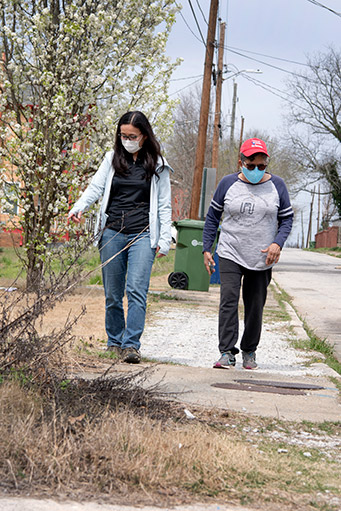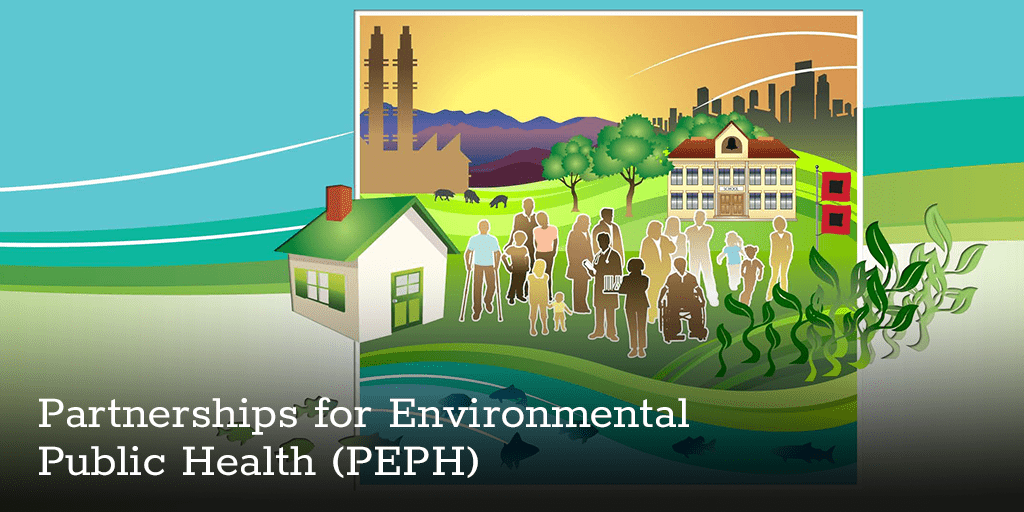Community Partnership’s Soil Sampling Workshops Address Lead Exposure Risk
Through a community gardening partnership, Emory University researchers tested soil and found high lead levels. In response, they implemented a neighborhood soil sampling workshop and have continued working with urban gardeners on safety initiatives. The project began in 2016.
The Saikawa lab, which is associated with Emory’s HERCULES Exposome Research Center and the Historic Westside Gardens, an Atlanta-based gardening organization, started the soil testing effort in west Atlanta. A March 2023 paper and a July 2023 paper describe the research team’s work in community-engaged soil screening initiatives and their continuation. Listen to the April 2022 PEPH podcast to hear more about the soil sampling study.
Initiating the Soil Sampling Project
When the City of Atlanta planned to develop urban gardens, the Saikawa lab wanted to see if the soil in the lots was safe. The urban agriculture project was proposed as a way to address food insecurity and increase access to healthy food.
Researchers from the Saikawa lab found soil lead levels exceeded the Environmental Protection Agency (EPA) threshold. As a result, the Saikawa lab and the Historic Westside Gardens partnered to expand screening efforts and community engagement around soil safety for gardening. When the soil was sampled and tested, the partners found that three of 11 home gardens in the neighborhood had unsafe lead levels.
Eri Saikawa and Rosario Hernandez, executive director of Historic Westside Gardens, collect soil samples from a yard. (Photo courtesy of Emory University)
In August 2018, the Saikawa lab and Historic Westside Gardens collected more soil samples from the community by hosting a Soil Screening, Health, Outreach, and Partnerships (soilSHOP) event during a local tomato festival. At this event, a resident brought a soil sample containing a rock-like substance that she was concerned about. Staff from the EPA identified the substance as slag, an industrial waste product of ore smelting. Researchers from the Saikawa lab analyzed the sample and found high lead levels. The research team shared the results with the state government who referred the issue to appropriate authorities at the EPA.
“This discovery made us go around in the neighborhood to look for slag,” stated Eri Saikawa, Ph.D., professor at Emory University’s Department of Environmental Sciences, and member of HERCULES. “We found many slag pieces visibly present in Atlanta’s Westside neighborhoods, and we realized the lead contamination may be present at a large scale.”

Saikawa and Hernandez walk through a neighborhood in west Atlanta. (Photo courtesy of Emory University)
The slag finding triggered several efforts. The EPA began investigating soil in nearly 60 lots in west Atlanta where the slag was initially found. They found high soil lead levels in more than half of the lots. As more testing was conducted, more lead contamination was found, and over time the area expanded to 2,097 lots. The area is now designated as a Superfund site and has been listed on the National Priorities List since March 2022.
At the same time, the team worked with the EPA to gain the community’s trust and participated in raising awareness by conducting door-to-door outreach. They also began providing seeds for plants that take up lead to help the community reduce soil lead levels. The team also hosted more soilSHOPs in majority-Black neighborhoods that faced socioeconomic disadvantages to screen for lead and address community-level environmental health issues. During the COVID-19 pandemic, the team established a virtual soilSHOP for residents throughout Georgia so more people could learn how to test their soil samples without in-person events.
Lead in soil is a public health concern because children who play outdoors and people who garden or participate in urban agriculture may be at greater risk of lead exposure. In fact, in the Federal Action Plan to Reduce Childhood Lead Exposure and Associated Health Impacts, the President’s Task Force on Environmental Health Risks and Safety Risks to Children cites reduction of lead in soil as a way to reduce childhood lead exposure.
Engaging the Community in Soil Sampling
The soil sampling project was initially planned as a small project for a graduate student. However, when high soil lead levels were found, the team sought help from the HERCULES research center. Through the HERCULES Stakeholder Advisory Board, a new partnership developed between the Saikawa lab, Historic Westside Gardens, the Centers for Disease Control and Prevention, the Agency for Toxic Substances and Disease Registry, and the EPA on soil lead contamination.
The soilSHOPs provided residents the opportunity to bring soil samples for free lead testing. To prepare for the events, partners sent out educational materials to residents with information on how to collect soil and get it tested. The partners were also at the events to present information on lead safety and the health risks of exposure. During COVID, drop-off boxes were set up and participants received information along with their soil test results via email.
Now, the Saikawa lab has increased its relationship with various community organizations and is hosting more soilSHOPs at local community events and at local middle and high schools.
“The partnership with the Historic Westside Gardens was a way for us to engage with residents, especially those who were interested in gardening and could therefore be exposed to soil lead,” reflected Saikawa. “Historic Westside Gardens was instrumental in getting residents involved in soil testing in the west Atlanta neighborhood and now we try to implement it in wider areas.”
Health Concerns at the Superfund Site
The Saikawa lab and the partners are now focused on addressing concerns raised by the community since the Superfund designation. For example, residents have expressed concerns about the lack of health assessments for the residents despite the Superfund designation. Those whose soil tested just below the EPA soil lead standard fear that their families, especially children, may still be at risk of negative health effects. Some have inquired about using plants as a cleanup method since it is a cost-effective way to reduce soil lead and beautify the neighborhood. The researchers and community partners continue working with the community to spread awareness of soil lead contamination and its health consequences and to assess children’s cumulative lead exposures.
As one resident stated, “This goes beyond just cleaning up the soil. This is about our health, and the health of our grandchildren growing up here now.”
Source link
www.niehs.nih.gov


